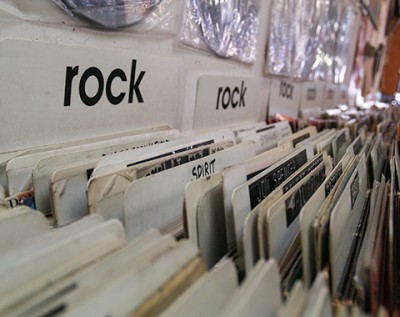
In an increasingly digital age, physical rock memorabilia is still a big-ticket item. Some people are even willing to spend millions of dollars for scraps of old scribbled lyrics.
Spending huge amounts of money on memorabilia may seem like a waste, but for music fans, these products have a certain quality that makes those multiple zeros worthwhile. Simply put, rock memorabilia connects older fans back to a time when they were young and happy.
George Howard, a music business and management professor at Berklee College of Music, called it the “Harry Potter theory of marketing.” In the first book of the series, Harry looks into the Mirror of Erised, or “desire” spelled backwards. He sees his late parents, and the image in the mirror makes Harry feel good about himself.
“Any product that does that to you…makes you feel like you are more profoundly representing yourself,” Howard said. “That’s a powerful product. For a generation of people, music has that power.”
This is what happened April 7, when the original manuscript for Don McLean’s 1971 hit song “American Pie” was auctioned off for $1.2 million. The lyrics were written on a piece of paper he found in the trash.
According to Howard, the baby boomer generation that came of age listening to bands such as the Grateful Dead and the Beach Boys is now the generation with the most disposable income. With this extra spending money, they are now looking for investments.
The music from bands of this generation has such a strong appeal due to what Howard calls the “reminiscence bump.”
“The things you listen to when you are in high school, those really formative ages when you’re becoming yourself, that music stays with you [for] your entire life,” Howard said. “It defined them when they were 20 and it defines them when they are 60.”
However, baby boomers aren’t the only ones affected by music’s powerful attraction. Even as online music streaming services grow in popularity, younger generations still invest in physical products like vinyl records.
Records arguably have better sound quality than digital music, Howard said, but there is also another, more personal reason behind records remaining popular merchandise.
“Vinyl is something you can hold, something you can put on your wall,” he said. “People come over to your dorm room or your house and can go through your record collections. In doing so, they get a glimpse into who you are.”
Even though the form of music has changed, it is still a way of expressing yourself. Music merchandise, whether it be a poster, t-shirt or a vinyl, is what Howard calls an “extreme manifestation of your internal values.” And that is what makes these items priceless.
Reed Lappin, owner of Allston record store In Your Ear, said that people of all ages and areas of the world come to buy merchandise from his store on Commonwealth Avenue. In recent years, however, his customers have increasingly been of a younger age. This, according to Lappin, can be explained quite simply.
“It’s a boring life, just looking at a screen all day,” he said.
However, Lappin also expressed his concern for the uncertain future of record sales. While record players seem to be coming back into fashion, he said, it is hard to tell what will happen in years to come. Other music professionals share this same concern as well.
“I think it’s going to be interesting to see whether memorabilia and physical things resonate with people who are coming of age in the digital generation,” said Allen Bargfrede, another music business and management professor at Berklee. “As you move past my generation and into people who grew up never owning a CD and never going to a record store, [they] may not necessarily [feel] tied emotionally to physical products. It might fade away.”
In case the popularity of physical memorabilia fades, Bargfrede said, artists are attempting to come up with new ways to capitalize on their fans’ willingness to spend money on music. Instead of spending thousands of dollars on a product, fans might be willing to spend it on VIP tickets to a concert, or passes to meet the artist. However, Bargfrede claimed that this tendency is still a part of the memorabilia movement.
“The artists [are] realizing,” he said, “‘Hey, not all fans are alike. Let’s modify this.’”

















































































































